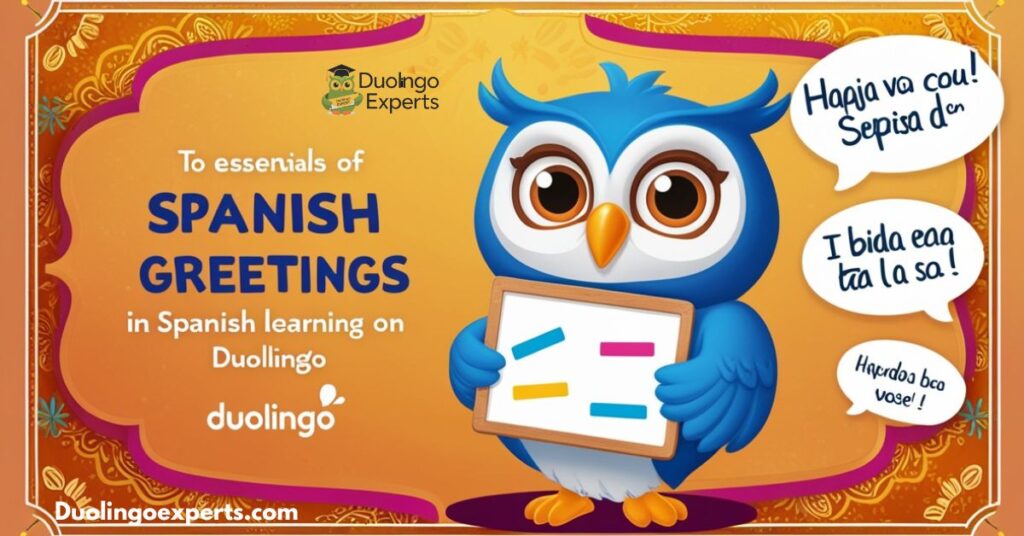Learning a new language can be an exciting adventure, but it can also feel overwhelming at first. Fortunately, thanks to language-learning apps like Duolingo, mastering essential phrases such as “How are you?” in Spanish becomes both accessible and enjoyable. Whether you’re just starting or looking to refine your skills, Duolingo’s unique gamified learning system makes it easier than ever to grasp the basics of the Spanish language.
In this post, we’ll delve into how Duolingo helps learners get familiar with basic greetings, including the all-important phrase “How are you?” We’ll cover practical tips to boost your Spanish speaking skills, how Duolingo structures its lessons, and why its interactive learning methods are so effective.
Key Takeaways
- Learn key Spanish phrases like “How are you?” and other essential greetings.
- Understand how Duolingo uses a skill tree to structure your learning journey.
- Explore the differences between formal and casual greetings in Spanish.
- Get practical tips on improving pronunciation and mastering time-of-day greetings.
Essential Spanish Greetings on Duolingo

When you first start your Spanish course on Duolingo, you’ll likely begin with the most basic and essential phrases. Learning Spanish greetings such as “Hola” (Hello) or “Buenos días” (Good morning) will be the first step toward understanding the language’s cultural nuances and engaging in conversations. These early phrases will serve as building blocks for more complex interactions as you progress.
Common Duolingo Greetings
- Hola – (Hi)
- Buenos días – (Good morning)
- Buenas tardes – (Good afternoon)
- Buenas noches – (Good evening / Good night)
- Adiós – (Goodbye)
- Mucho gusto – (Nice to meet you)
These basic greetings are simple but incredibly powerful when initiating a conversation in Spanish. Duolingo helps you master these through repeated exercises that encourage active recall. The app allows you to practice these phrases in various contexts, from casual conversations with friends to formal introductions.
Duolingo Teaching Methods for Greetings
The interactive language learning offered by Duolingo makes these greetings stick in your memory. You’ll practice listening to native speakers say the phrases, then repeat them aloud, and the app will give you instant feedback on your pronunciation. The gamified design of Duolingo means you’ll be encouraged to keep practicing these greetings until you feel confident using them in real-world conversations.
This active recall method is crucial for language retention. As you repeat phrases like “Buenos días” and “Hola” in different contexts, Duolingo solidifies these expressions in your memory, helping you use them naturally when speaking with Spanish speakers.
Morning and Evening Expressions
In Spanish, greeting someone changes depending on the time of day. Duolingo makes sure to emphasize the importance of time-of-day greetings in its lessons. Whether it’s morning, afternoon, or evening, the greeting you use tells the other person something about your level of respect and awareness of cultural norms.
Common Time-of-Day Greetings:
- Buenos días – (Good morning)
- Buenas tardes – (Good afternoon)
- Buenas noches – (Good evening / Good night)
Each of these phrases has its own designated time. Buenos días is used from early morning until around noon, Buenas tardes is used from noon until evening, and Buenas noches is typically reserved for after sunset or when parting ways in the evening. These time-sensitive greetings are not only practical but also show respect for the time of day in Spanish-speaking cultures.
Duolingo Approach to Teaching Time-of-Day Greetings

Duolingo incorporates these time-of-day greetings in its Spanish vocabulary modules, using both written and audio exercises to reinforce them. You might be prompted to identify the correct greeting for a specific time of day, or even listen to a conversation where these greetings are used naturally.
Additionally, Duolingo’s repetition system ensures that these phrases are constantly reviewed, helping you retain them over time.
Casual vs Formal Greetings
One important concept that Duolingo highlights early in your learning journey is the difference between casual and formal greetings in Spanish. In many Spanish-speaking cultures, the language used in a greeting reflects the level of respect and familiarity you have with someone. Duolingo makes sure to introduce both types of greetings to give you a complete understanding of Spanish social etiquette.
Informal Greetings (Used with Friends, Family, Peers)
- ¿Cómo estás? – (How are you?) This informal phrase is used with friends, family members, or people you are familiar with.
- ¿Qué tal? – (What’s up?) Another casual greeting often used among peers or younger people.
Formal Greetings (Used with Strangers or People You Don’t Know Well)
- ¿Cómo está usted? – (How are you?) This is the formal version of “How are you?” and is used when speaking with someone older, more formal, or a stranger.
Duolingo teaches you when to use each type of greeting through various exercises. You’ll also encounter interactive learning opportunities where you can practice these greetings in different situations, helping you feel more comfortable using the right phrase at the right time.
Basic Thank You Phrases
Once you’re familiar with greetings, Duolingo introduces other key Spanish expressions like thank you and you’re welcome, which are crucial in polite conversation. These phrases are among the first common phrases that learners encounter, making them essential for building a polite and respectful dialogue in Spanish.
Common Thank You Phrases:
- Gracias – (Thank you)
- Muchas gracias – (Thank you very much)
- De nada – (You’re welcome)
- Por favor – (Please)
- Perdón – (Sorry)
These phrases are introduced early on in Duolingo’s lessons, along with interactive prompts that allow you to practice. For example, you may encounter a dialogue where someone thanks you, and you’ll need to reply with “De nada” or “Por favor.” These repeated interactions are designed to make these expressions second nature in conversations.
How Are You in Spanish on Duolingo
One of the most important phrases you’ll learn as a beginner is “How are you?” Duolingo focuses heavily on teaching this phrase early in your lessons. It’s the foundation for any conversation, and knowing how to ask this question will make you feel more confident when speaking with others in Spanish.
Duolingo’s Approach to Teaching “How Are You?”
The two variations of “How are you?” that Duolingo teaches are:
- ¿Cómo estás? – (Informal)
- ¿Cómo está usted? – (Formal)
Both are equally important, as they serve different social purposes. Duolingo presents them in contexts where you have to choose the correct version depending on the person you’re speaking with. For example, if you’re speaking to a friend or family member, ¿Cómo estás? is the go-to phrase. However, if you’re addressing someone older or a stranger, you’d use ¿Cómo está usted? to show respect.
Duolingo encourages learners to practice these phrases by listening to audio recordings, repeating the phrases aloud, and typing the answers. The more you practice, the more naturally these phrases will roll off your tongue.
Duolingo Skill Tree Structure

One of the most unique features of Duolingo is its skill tree structure, which organizes your learning into distinct categories and ensures steady progress. The skill tree visualizes the path you take as you move from one lesson to the next. This structure is designed to make learning both manageable and rewarding.
Key Features of the Duolingo Skill Tree:
- Skills and lessons: Duolingo breaks the learning process down into smaller chunks, allowing you to master specific areas (e.g., greetings, common phrases, verbs, etc.).
- Practice mode: After completing a set of lessons, you can practice the skills you’ve learned so far. This reinforces your knowledge and prevents forgetting.
- Skill progression: As you complete each skill, you unlock new levels and categories, allowing you to progress at your own pace.
By structuring lessons in a tree-like fashion, Duolingo helps learners see their progress. It also makes it easy to jump into new lessons as soon as you feel ready, keeping motivation high.
Lesson Progress System
Duolingo’s lesson progress system provides feedback on your learning journey, ensuring that you stay on track and motivated. The system is designed to reward consistency and effort, and the more you practice, the faster you’ll advance.
Key Elements of Duolingo’s Progress System:
- XP Points: Earned by completing lessons and exercises.
- Crowns: Represent your mastery of a skill, gained by revisiting and completing specific lessons.
- Fluency Score: This score shows how fluent you are in Spanish based on your lesson progress and overall proficiency.
Duolingo uses these metrics to encourage learners to keep going, rewarding them for completing challenges, answering questions correctly, and practicing consistently.
Interactive Learning Methods in Duolingo Spanish
Duolingo’s success lies in its interactive learning methods. Rather than just passively reading or listening, you’ll engage with the language by actively participating in exercises. This makes learning far more effective and enjoyable.
Interactive Features:
- Speech recognition: You’ll speak the phrases aloud and get instant feedback on your pronunciation.
- Listening exercises: Listen to sentences spoken by native speakers and identify what’s being said.
- Real-time feedback: Duolingo immediately tells you when you make a mistake, allowing you to learn from it right away.
These interactive features ensure that you’re not just memorizing vocabulary; you’re using it in practical, real-world contexts.
Pronunciation Tips
Pronunciation is a crucial element of learning any new language. Duolingo provides valuable pronunciation tips throughout the course to help you sound more authentic when speaking Spanish.
Pronunciation Tips from Duolingo:
- Practice difficult sounds: Spanish has a few tricky sounds, such as the rolling “r” or the soft “d” sound. Duolingo will guide you through these with specific exercises.
- Slow down: If you’re struggling with pronunciation, use the app’s feature that lets you listen to words slowly. This gives you a chance to mimic the sounds more accurately.
- Repeat aloud: The more you speak, the more confident you’ll become. Duolingo encourages you to repeat phrases aloud until they sound natural.
Real-Time Feedback
Duolingo’s real-time feedback is a game-changer when it comes to learning Spanish. The app doesn’t wait for you to finish a full lesson before correcting you. Instead, it offers immediate feedback as you go, helping you learn from your mistakes in real-time.
Benefits of Real-Time Feedback:
- Instant corrections: If you make a mistake, Duolingo will tell you right away, explaining the correct answer.
- Progress tracking: The app tracks your performance, giving you tips on where to improve.
- Boosts motivation: Instant feedback makes you feel more connected to the learning process and motivated to keep going.
Frequently Asked Questions
What are three ways to say how are you in Spanish?
Three ways to say “How are you?” in Spanish are:
- ¿Cómo estás? (Informal)
- ¿Cómo está usted? (Formal)
- ¿Qué tal? (Casual)
How do you say “how are you” in Spanish Duolingo?
In Duolingo, you learn to say “How are you?” in Spanish as “¿Cómo estás?” (informal) and “¿Cómo está usted?” (formal). These phrases help you engage in conversations based on the level of formality.
How are you Spanish formal?
The formal way to say “How are you?” in Spanish is “¿Cómo está usted?”. It is used when addressing someone with respect, such as an older person or a stranger.
What does Mucho Gusto mean in Spanish Duolingo?
In Duolingo, “Mucho gusto” means “Nice to meet you.” It’s a polite way to greet someone when you’re introduced.
How to respond to que tal?
To respond to “¿Qué tal?”, you can say “Bien, gracias” (Good, thank you) or “Todo bien” (Everything’s good). These are casual, common replies in informal settings.
What does Como Andas mean?
“¿Cómo andas?” is an informal way to ask “How’s it going?” in Spanish. It’s commonly used in casual conversations, especially among friends.
How do you reply to “Cómo estás?”?
To reply to “¿Cómo estás?”, you can say “Estoy bien, gracias” (I’m good, thank you) or “Estoy mal” (I’m not doing well). These responses depend on how you’re feeling.
Is qué pasa formal or informal?
“¿Qué pasa?” is an informal phrase used to ask “What’s happening?” or “What’s up?”. It is typically used among friends or people you know well.
What does hasta manana mean?
“Hasta mañana” means “See you tomorrow” in Spanish. It’s a friendly way to say goodbye when you expect to see someone the next day.
How to respond to “Cómo te llamas”?
To respond to “¿Cómo te llamas?” (What’s your name?), you can say “Me llamo [Your Name]” (My name is [Your Name]). It’s a simple and common way to introduce yourself in Spanish.
Conclusion
Mastering basic Spanish greetings and key phrases like “How are you?” is an essential first step in your language-learning journey. Duolingo makes this process enjoyable and effective through its interactive learning, personalized lessons, and gamified features. Whether you’re just starting or already on your way to becoming conversational in Spanish, Duolingo’s unique approach offers everything you need to succeed.
By learning and practicing consistently, you’ll be able to have basic conversations, ask how others are doing, and respond appropriately in any situation. So dive into your Duolingo Spanish lessons, take advantage of the app’s rich features, and start speaking Spanish with confidence!
>>>Read Also: Duolingo Kids: Fun Language Games & Learning Activities for Children

DuolingoExperts, managed by MarkJohan, offers expert insights and tips for mastering languages. A tech-driven platform to enhance your learning experience.

